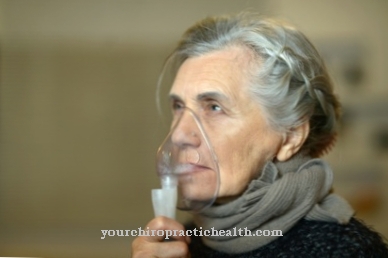With the thyroid gland, larynx, trachea and esophagus, the neck is home to important human organs that play a major role in vital functions such as breathing and communication. One that occurs suddenly Lump on the neck should therefore not be disregarded. While neck swelling disappears on its own in many cases, medical treatment is essential for certain causes.
What is a bump on the neck?

A bump on the neck is a swelling that can appear in different parts of the neck. Depending on the cause, the bump can vary in characteristics such as size, location, and consistency. While some bumps are barely noticeable and stuck, others are enormous, hard and easy to move.
The speed of their growth and the course of their disease also depend on the cause of the disease and therefore cannot be specified precisely. Neck swellings are also accompanied by different symptoms. Some bumps cause pain or impede breathing, voice or swallowing functions. In addition, a bulge on the neck can usually be easily recognized from the outside due to its protrusion.
causes
A bump on the neck can result from a variety of different factors. Often, however, there is inflammation of the lymph node. A distinction is made between non-specific and specific lymph node inflammation. While unspecific inflammation is caused by bacterial or viral infections of the head area, specific inflammation of the lymph nodes has a certain cause of the disease.
This can include diseases such as tuberculosis, syphilis, AIDS or Boeck's disease. In other cases, a bump on the neck is also caused by a neck cyst or fistula, which can be very painful in the inflamed stage. Cysts are special tissue cavities that are filled with fluid. The bumps are usually in the form of a so-called median neck cyst above the larynx or as a lateral neck cyst on the side of the neck at the angle of the jaw.
In addition, in the event of inflammation, they can cause reddened skin. Neck fistulas, in turn, represent minimal openings in the skin from which secretion is permanently draining. If there is an isolated collection of pus, the swelling on the neck is again due to an abscess.
Another reason for a neck bulge can be an occlusion of the large jugular vein, medically jugular vein thrombosis. A blood clot, usually caused by medical measures, clogs both skin veins, causing them to become inflamed. An acute jugular vein thrombosis can be identified by a soft and painful bulge in the neck, which is often accompanied by fever.
In contrast, a chronic occlusion of the large jugular vein shows up in a hard and mostly painless bump on the neck. Often an enlargement or a lump of the thyroid gland also promotes the development of a neck swelling. These can develop as a result of iodine deficiency, special medications, autoimmune and cancer diseases or inflammation of the thyroid gland. Diseased salivary glands are also possible causes of bumps on the neck.
Most of these are bacterial or viral caused by diseases such as mumps. If there is no pain and slower growth, a swelling of the neck can in rare cases hide a malignant cancer.
Diseases with this symptom
- Inflammation of the lymph nodes
- Sarcoid
- Throat fistula
- Abscesses
- Jugular vein thrombosis
- mumps
Complications
As a rule, bumps on the neck are not directly related to the development of complications. In certain cases, however, the swellings may indicate metastases in the neck region.
Patients are affected by a high health risk, since it is then a malignant cancer. Intensive therapy of the tumor can in turn cause symptoms such as hair loss, pain sensations, sluggishness and weight loss. In addition, the general well-being of the patient is considerably reduced and thus promotes the development of mental illnesses. Other complications are complaints during swallowing, breathing or speaking.
When should you go to the doctor?
Depending on the extent and background of the bump on the neck, it may need to be clarified by a doctor. This is especially true if the swelling cannot be explained by simple diseases such as sore throat. A bump on the neck that is associated with severe pain or that has persisted for weeks generally requires detailed clarification.
A serious tumor disease could be the cause here. The right contact person for a sore throat is primarily an ear, nose and throat specialist. A general practitioner can provide initial relief for simple complaints.
Doctors & therapists in your area
diagnosis
When diagnosing a bump on the neck, the primary aim is to clarify the cause. For this purpose, a detailed anamnesis of the previous course of the disease in the patient is carried out, at which point in time and possible accompanying symptoms are the focus of the survey.
During the subsequent physical examination, the existing swelling will be examined more closely by the doctor. The bump is classified according to characteristics such as "hard" or "soft", "painful" or "painless", "tight" or "loose" and the cause is thus narrowed down. A subsequent ultrasound examination can provide further facts about the origins of the swelling.
For example, cysts, lymph nodes or abscesses can be detected with the help of this so-called sonography. To diagnose diseases of the thyroid gland, however, other methods such as magnetic resonance imaging or computed tomography are usually necessary. Blood tests can also provide results on possible infections that are causing the neck bulge.
Treatment & Therapy
Depending on the diagnosed cause, the form of therapy for a bump on the neck differs. If the swelling of the neck is caused, for example, by a non-specific inflammation of the lymph nodes, treatment is usually not given. Because after overcoming the causative infection, the bump usually recedes independently.
However, in rare cases, special drugs are prescribed for the infection. The same applies to specific lymph node inflammation, which, depending on its cause, may require different medications. Any jugular vein thrombosis and inflammation of the salivary glands are also treated with medication. However, if inflammation of the salivary glands occurs repeatedly, surgical removal of this is often essential.
Cysts, abscesses, or fistulas underlying neck swellings also require surgery. In addition, if there are indications of serious illnesses such as cancer or inexplicable enlargement of the lymph nodes, the lymph nodes are surgically removed so that they can be thoroughly examined in the laboratory. In this way, a suspected suspicion can be definitively confirmed and the disease treated.
If a bump develops on the neck as a result of an enlargement of the thyroid gland, its therapy differs depending on the individual extent and cause of the swelling. In addition to medicinal or surgical measures, radioiodine therapy can also be carried out.
Outlook & forecast
The chances of healing a bump on the neck depend on the cause of the swelling. Usually, however, a benign change with a positive course of the disease can be assumed. In particular, bumps caused by infections and inflammations usually recede as a result of combating the cause. Even with cysts or tumors as causes of development, it is a benign structure that can be successfully removed.
If, on the other hand, the swelling is the result of a malignant tumor or cancer, the prognosis may be worse. Early diagnosis and treatment are crucial here, so that a doctor should be consulted immediately at the first signs of a bump on the neck or pain.
You can find your medication here
➔ Medicines against swelling of the lymph nodesprevention
There are some measures that can be taken to prevent a bump from developing on the neck. The main aim is to prevent diseases that can cause swelling of the neck. Therefore, your own body should always be observed and possible indications of a disease noticed and assessed at an early stage.
Swelling caused by infections can be largely prevented, for example, by taking typical preventive measures for a cold. Sufficiently warm clothing and a balanced diet rich in vitamins are recommended in this context.A healthy diet also counteracts the development of an overactive thyroid.
You can do that yourself
When a bump appears on the neck, those affected can take certain measures to create initial remedies on their own to alleviate pain and possible side effects. This is especially true for harmless neck swellings.
Probably the simplest remedy for the sore throat underlying the bump is drinking various teas such as chamomile or peppermint tea. The tea reduces inflammation and pain. This home remedy is particularly effective when the vapors of the tea are inhaled under a towel. Gargling the tea is also useful to significantly extend the exposure time in the throat.
Cooling wraps around the neck, in turn, help with enlarged lymph nodes that are the cause of the bump. Cold quark, lemon or vinegar compresses are ideal as wraps. Also compresses with angelica reduce any swelling and support the healing process considerably. The ointment required for this can be purchased in a conventional pharmacy and applied to a cotton cloth and wrapped around the affected area of the neck. For optimal effect, the application should be repeated up to three times a day.
In other cases, however, warm wraps are used, for example in the form of a warming bottle. Cooling or warming compresses and compresses can also be useful for bumps caused by inflammation of the salivary glands. Furthermore, those affected by inflammation of the salivary glands should pay attention to an adequate diet. Predominantly soft food and a sufficient amount of fluids are recommended. In addition, thorough oral hygiene can promote healing. An additional intake of saliva-stimulating agents such as chewing gum, candy, sour juices or lemons is also useful to clean the salivary glands.
In addition, there are homeopathic remedies for self-treatment of swelling on the neck and its causes. In this context, those affected with inflammation of the salivary glands are advised to take Phytolacca D12, while cervical bulges caused by swollen lymph nodes or tonsils are treated with Mercurius solubilis D12. An exact selection and dosage of a remedy is possible through the advice of an experienced homeopath.
Ultimately, Schüßler salts are said to have a healing effect on swollen lymph nodes. Number 4 potassium chloratum and number 9 sodium phosphoricum are particularly recommended. In the case of extreme salivation, however, it makes sense to add number 8 sodium chloratum. Detailed advice from an experienced doctor or therapist is recommended in order to give the patient the best possible treatment for his sore throat.






.jpg)




















